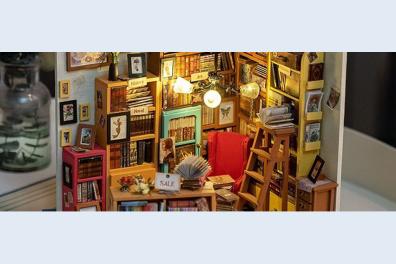Call for entries: "The museum in the home: interior literature

Call for papers: "Le musée dans la maison : la littérature d'intérieur" - Literary Museums at Home: Literature Indoors
As part of the project MuséaLitté, we invite contributions that explore different forms of display and appropriation of literature in the domestic or intimate setting of the home from a variety of approaches: literary studies, art history, art sociology, history of ideas, etc. At a time when house museums are developing and attracting an ever-growing and varied public, it seems pertinent to ask ourselves about the relationship between the museum and the home: do museums inhabit us as much as we visit them? how do they inform our habitats? in what way do they affect our practices and habits? when and why make a museum in one's home, or even a museum of one's home? Finally, what do these literary interior museums tell us about what literature is, what it does, what we do with it?
Some everyday practices constitute forms of museum mediatization of literature. Decoration and design, crockery, fashion and wardrobe, the display of certain brands, even disguises, not to mention board games and children's toys, can all be seen as ways of inscribing the literary in the home. Can we not then consider that the home constitutes a form of literary museum, a place for the intimate display of literary material, but also a place for the production of narratives or discourses on literature? The home can also be a place for the production of objects inspired by literature, notably in certain practices on the borderline between work and work, art and craft-think of samplers, patchwork, embroidery and other ladies' works inspired by literary texts, but also to artistic, craft or leisure practices that take text, book, or even iconotext or illustration as their material, from scrapbooking to art brut by way of decoration or cartoons for tapestries or canvases. We'll be looking at these practices at the crossroads of the home, the museum and the studio, as well as at the guides and websites that present them and make them accessible to the widest possible audience, and at the use of literary material in art-think of reworked portraits of authors and books that have been modified, sculpted, or whose pages serve as a support for graphic art forms.
Literature and the literary can also constitute collection themes, or even objects of worship or fetishism. We'll be looking at all forms of bibliomania, from rare editions to autographed books and editorial collections. Similarly, the altar at the heart of the house, made up of an accumulation of derivative products like so many literary fetishes on display, is reconfigured according to a museum logic. Contributions may examine the phenomenon of literary-themed collections, or the objects themselves - portrait medallions with or without quotations, photographs, busts, engravings, writers' death masks - as well as the cultural practices and strategies aimed at bringing literature into the home through missals, books for New Year's presents, encyclopedias or prize books. The question of the value of literature, through these sometimes unusual, even apocryphal objects, their circulation via auction rooms or other collectors' circuits, and the literary material that all these relationships to the object raise, may also be analyzed.
This duality of the domestic literary landscape as both a space for staging the literary and a space for producing literature, which refers to the writer's two bodies as Ernst Kantorowicz theorizes the king's two bodies ("the authors's double body", see Nicola Watson, The Author's Effect : On Writer's House Museums, 2020) is, moreover, particularly visible when the house becomes the medium of the writing gesture, whether its walls or gardens are adorned with quotations or original text. We'll be looking at these florilegia, as well as the literary forms of the curiosity cabinet and the reliquary, or the gestures that lend a literary cachet to a library, a living room, an office, but also a garden shed, an attic, a residence or a hotel room, or even smaller or more mobile spaces like the portable museum or Marcel Duchamp's boîte-en-valise.
For that matter, some writers work in a hybrid room inherited from the "enchanted ground" of nineteenth-century English novelists ("enchanted ground" see Nicola Watson), somewhere between study and museum space, such as Sigmund Freud's famous cabinet in Vienna or André Breton's studio in Paris. Both were subsequently preserved in the form of a house museum, the Freud Museum in Greater London, and the "Breton Wall" at the Centre Pompidou. Contributions analyzing the ways, past or contemporary, in which writers inhabit their homes when these tend to become museums during their lifetime, especially when the objects these writers-curators of their own ego-museums accumulate are intimately linked to their writing activity, are welcome.
The chapters of this collective work, written in French or English, will explore how interior literature influences, informs and transforms our everyday practices, along the lines opened up above in a non-exhaustive way, in Europe as in the rest of the world from the Middle Ages to the present day. Theoretical, comparative and diachronic approaches are welcome, as are case studies.
Proposals (500 words maximum) should be sent before Friday, October 15, 2021 together with a short bio-bibliography to the following three addresses:
Anne Chassagnol (Université Paris 8): anne.chassagnol@univ-paris8.fr
Sylvie Kleiman-Lafon (Université Paris 8): sylvie.kleiman-lafon@univ-paris8.fr
and Caroline Marie (Université Paris 8): caroline.marie.up8@gmail.com
Responses will be sent at the end of October 2021.
Chapters will be due on Monday, February 28, 2022.

Appel à contribution « Le musée dans la maison : la littérature d'intérieur » (813.69 KB, .pdf)